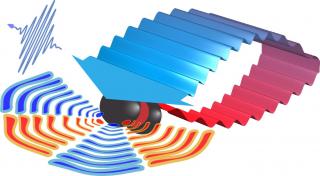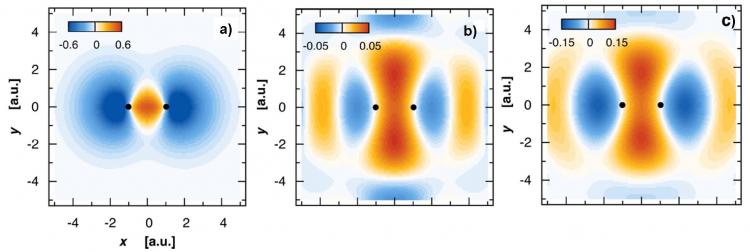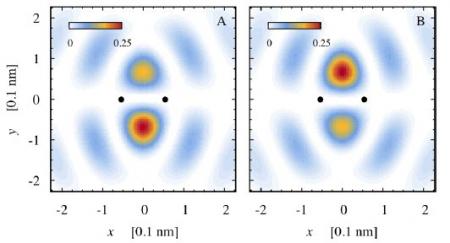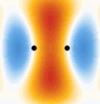|
Visualizing the motion of electrons in matter requires both a spatial resolution at the Angstrom scale and a temporal resolution at the attosecond scale (1 as = 10-18 s). Such an "ultra-fast camera" opening a path towards "viewing the electrons" is demonstrated: it allows imaging molecular orbitals using the ultra-short attosecond emission from this orbital in an intense laser field. In a close collaboration, scientists from IRAMIS-SPAM, LCPMR of the Univ. Paris 6 and from CNRS (UMR 7614) have shown, in experiments realized within the CEA-Saclay, the possibility of an "Attosecond-Angstrom" imaging in the case of the nitrogen molecule N2. |
In matter, bound and free electrons evolve on ultra-short time scales. An order of magnitude is given by the period of revolution on the first Bohr orbit which is 150 attoseconds. More precisely, a system whose inner-shell is excited relaxes by electron rearrangement within a few femtoseconds or less (Auger de-excitation). Similarly, a broadband excitation produces a coherent electronic wave packet (EWP), either bound or free, with an attosecond dynamics (a 10 eV energy width of the EWP corresponds to a characteristic time of 200 as). In a molecule, the ultra-fast deformation of the electron cloud - for example in the presence of a laser excitation - triggers the motion of nuclei (vibration, dissociation). In turn, this motion causes the distortion of the orbital on sub-femto (in systems with light nuclei, e.g., H) or femtosecond time scales; the spatial scale of the distortion is the Angstrom.
The ultimate objective of molecular dynamics would be therefore to monitor the distortion of orbitals at these extreme space and time scales. The orbital imaging relying on electron dynamics in a laser field could open very promising prospects towards this goal.

Schematic view of the generation of an attosecond harmonic pulse in the far UV, induced by an intense laser pulse forcing the oscillation of the electronic cloud (ionization followed by a radiative recombination).
When an atom or a molecule (gas phase) interacts with an intense laser field, the sequence of the three following steps plays a particularly important role :
- i) tunnel ionization releasing a quasi-free electronic wave packet in the continuum,
- ii) acceleration of the EWP up to energies of a few 10 to 100 eV,
- iii) recollision of the EWP with the ionic core.
In the recollision, the radiative recombination of the EWP with the core is one of the open inelastic scattering channels, which leads to the emission of attosecond light pulses of frequency in the extreme-UV range (wavelength typically 1 nm - 100 nm). This process which repeats every half-cycle in the laser pulse is highly non linear with respect to the field strength and frequency; it is referred to as high-order harmonic generation since the extreme-UV frequencies are usually displayed as odd multiples of the fundamental laser frequency.
In 2004, Itatani et al. [i] proposed to exploit the recollision of the EWP with the ionized orbital (core) from which the EWP originates as a probe of this orbital ("self-probing"); the EWP probe is ultra-short, of a few 10 to 100 as duration; its spatial resolution is given by its de Broglie wavelength, in the Angstrom range. Information on the orbital is encoded in the attosecond emission, specifically in the dipole which couples the molecular orbital to the recolliding EWP of momentum k. Information is reached by analyzing completely the amplitude and the phase of the emitted light in a broad spectral range, for different angles of alignment of the (linear) molecule versus the laser field. Itatani et al. have shown that, in principle, one can reconstruct the orbital from the dipole using a tomographic procedure (inversion of the dipole between the reciprocal space (momentum k) and the real space).
For several years the Attophysics group has developed highly efficient techniques to fully characterize and control the attosecond emission in atoms [2] and molecules [3]. In a recent work published in Nature Physics [4], , we report the first purely experimental tomographic reconstruction of the outer valence orbitals HOMO (Highest Occupied Molecular Orbital) and HOMO-1 in the nitrogen molecule N2.
Figures a) and b) show the HOMO (of σg symmetry) in amplitude and in phase (sign), respectively, "exact" from a Hartree-Fock calculation, and experimentally reconstructed from the harmonics of order 17-31 (spatial frequencies k between 18 nm-1 and 30 nm-1 in the reciprocal space). The reconstructed orbital, though it does not fit rigorously the exact orbit, remarkably shows its characteristic structure - internuclear distance, positive/negative lobes. The spatial resolution at the Angstrom scale is directly related to the finite range of spatial frequencies k. Figure c) shows the orbital obtained when the same tomographic reconstruction as from experiment is simulated from theory, that is retaining a finite range of discrete spatial frequencies. The excellent agreement between b) and c) validates the tomographic method based on attosecond emission in a laser field for imaging molecular orbitals.

HOMO orbital of the nitrogen molecule N2, a) calculated exactly (Hartree-Fock), b) experimentally reconstructed by the tomographic method based on attosecond emission in a laser field, c) reconstructed theoretically in the same conditions as experimentally in b ). The reconstructed orbital b) shows the characteristic structure, amplitude and sign of the exact HOMO.

Reconstruction of the wave function at two separate times separated by 1500 ± 300 as. This allows visualizing the movement of a "hole" in the electron density produced by the interaction of the nitrogen molecule with the intense laser pulse. The black dots indicate the position of the atoms in the molecule.
In the same study, we were able to capture an "image" of the attosecond electron dynamics in the molecule. Indeed, tunnel ionization (above step i)) produces a "hole" in the bound electron wave packet, which is spatially localized (as the result of the coherent superposition of "holes" in the HOMO and HOMO-1) and oscillates with a periodicity of 3 fs. We have reconstructed two snapshots of the hole with temporal resolution of 600 as. These first "pictures" of attosecond dynamics in a molecule demonstrates the potential of imaging based on attosecond emission in a laser field.
In the following, we will seek to increase the spatial resolution, firstly by extending the emission spectral range (attosecond emission induced by mid-infrared laser), secondly by controlling the recollision of the EWP using a second laser field. Further, we will investigate the distortion of orbitals in dynamical processes such as dissociation and isomerization.
The orbital imaging program is developed in collaboration with the Institute for Molecular Sciences d'Orsay (ISMO), the Laboratoire de Chimie Physique-Matière et Rayonnement (Université P. & M. Curie) and the Centre Lasers Intenses et Applications (CELIA - Bordeaux). It is funded by the ANR-blanc 2009 ATTOWAVE contract.
References :
[1] Itatani, J. et al., Nature 432, 867-871 (2004)
[2] Mairesse, Y. et al., Science 302, 1540-1543 (2003)
[3] Boutu W. et al., Nature Phys. 4, 545-549 (2008)
|
[4] Attosecond imaging of molecular electronic wavepackets |
 |
- See also :
-
"News and Views" comments in Nature Physics :
"Ultrafast science: Towards a one-femtosecond film",
O. Smirnova and M. Ivanov, Nature Physics 6 (2010) 159. -
 CEA-CNRS press release : Première "photographie" d'électrons en mouvement dans une molécule
CEA-CNRS press release : Première "photographie" d'électrons en mouvement dans une molécule
(see laso : on line CEA Press release)
-
The former highlight in the field (may 2008) :
Using molecules to control attosecond light pulses
-
"Des flashs toujours plus courts", P. Salières, T. Ruchon et B. Carré,
Les Dossiers de La Recherche, N°38, Février 2010, p.60-64.
-
 The article in "Le Monde", dated February 27, 2010.
The article in "Le Monde", dated February 27, 2010.
* CEA-Saclay, IRAMIS, Service des Photons, Atomes et Molécules, 91191 Gif-sur-Yvette, France
+§Laboratoire de Chimie Physique-Matière et Rayonnement, UMR 7614, CNRS & UPMC Univ. Paris 06, 11 rue Pierre et Marie Curie, 75231 Paris Cedex 05, France.
•  Laser-matter interaction › Photoscience, Lasers, Plasmas
Laser-matter interaction › Photoscience, Lasers, Plasmas
• Interactions, Dynamics and Lasers Laboratory (LIDYL) - CEA-CNRS and Paris Saclay University • Service des Photons Atomes et Molécules












